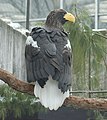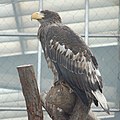Steller's Sea Eagle
| Steller's Sea Eagle | |
|---|---|
 | |
| At Heidelberg Zoo, Germany | |
| Conservation status | |
| Scientific classification | |
| Kingdom: | Animalia |
| Phylum: | Chordata |
| Class: | Aves |
| Order: | Falconiformes (or Accipitriformes, q.v.) |
| Family: | Accipitridae |
| Genus: | Haliaeetus |
| Species: | H. pelagicus |
| Binomial name | |
| Haliaeetus pelagicus (Pallas, 1811) | |
| Subspecies | |
see text.
| |
 | |
| Orange: breeding only Green: resident all year Blue: winter only Purple: vagrant range. | |
| Synonyms | |
Aquila pelagica
Pallas, 1811 | |
The Steller's Sea Eagle, Haliaeetus pelagicus, is a large bird of prey in the family Accipitridae. It lives in coastal northeastern Asia and mainly preys on fish. On average, it is the heaviest eagle in the world, at about 5 to 9 kilograms (11 to 20 lb; 0.79 to 1.4 st), but often lags behind the Harpy Eagle and Philippine Eagle in some other measurements. This bird is named after the German naturalist Georg Wilhelm Steller.
Description, systematics, and status
Steller's Sea-eagle is the biggest bird in the genusHaliaeetus and is one of the largest raptors overall. The typical size range is 85 to 94 cm (33 to 37 in) long and the wingspan is 1.95 to 2.5 m (6.4 to 8.2 ft).Females typically weigh from 6.8 to 9 kilograms (15 to 20 lb; 1.07 to 1.4 st), while males are rather lighter with a weight range from 4.9 to 6 kilograms (11 to 13 lb; 0.77 to 0.94 st). An unverified record exists of a huge female, who apparently gorged on salmon, having weighed 12.7 kilograms (28 lb; 2.00 st).
Two subspecies have been named: The relatively widespread nominate pelagicus and the virtually unknown H. p. niger.The latter name was given to the population which lacked white feathers except for the tail and supposedly was resident all year in Korea. Last seen in 1968 and long believed to be extinct, a female matching H. p. niger in appearance was born in captivity in 2001. Both its parent were "normal" in appearance, indicating that H. p. niger is an extremely rare morphrather than a valid subspecies, as had already been suggested earlier.
The relationships of Steller's Sea-eagle are not completely resolved. mtDNA cytochrome bsequence data tentatively suggests that this species's ancestors diverged early in the colonization of the Holarctic by sea eagles. This is strongly supported by morphological traits such as the yellow eyes, beak, and talons shared by this species and the other northern sea-eagles, the White-tailedand Bald Eagles, and biogeography.It is unique among all sea eagles in having a yellow billeven in juvenile birds, and possessing 14, not 12, rectrices. The skull (at about 14.6 cm (5.7 in)) and bill are the largest of any eagle and comparable in size to the largest Old World vultures, the biggest accipitrids.
Distribution and habitat
Steller's Sea Eagle breeds on the Kamchatka Peninsula, the coastal area around the Sea of Okhotsk, the lower reaches of the Amur river and on northern Sakhalin and the Shantar Islands,Russia. The majority of birds winter farther south, in the southern Kuril islands, Russia andHokkaidō, Japan. That being said, the Steller's Sea-eagle is less vagrant than the White-tailed Eagle, usually lacking the long-range dispersal common in juveniles of that species.
The large body size (see also Bergmann's Rule) suggests that it is a glacial relict, meaning that it evolved in a narrow subarctic zone of the northeasternmost Asian coasts, which shifted its latitudeaccording to ice age cycles, and never occurred anywhere else.
Vagrant eagles have been found in North America and Taiwan but these are considered to be individual eagles that have strayed from the species' typical range.
This bird nests in two habitats: along sea coasts and in large rivers with mature trees. They nest on large, rocky outcroppings or at the tops of large trees. Some eagles, especially those that nest in sea coast, may not migrate. Steller's sea eagles that do migrate fly down to winter in rivers and wetlands in Japan but will occasionally move to mountainous inland areas as opposed to the sea coast. They are also occasionally seen over and perching on sea ice in northern waters during the winter.
Diet
The Steller's Sea-eagle mainly feeds on fish. Favored prey include salmon (Onchorhynchus spp.),trout and cod. Like most Haliaeetus eagles, they hunt fish almost exclusively in shallow water. Relatively large numbers of these normally solitary birds can be seen congregating on particularly productive spawning rivers due to an abundant food supply.Besides fish, it also preys on water-dwelling birds (including ducks, geese, swans, cranes, herons and gulls), various mammals,crabs, mussels, squid and carrion. Along the sea coast, water birds are the most commonly caught prey. Among bird prey, this eagle has shown a strong local preference for Slaty-backed Gulls.Carrion, especially that of mammals, is readily taken during the winter. This eagle has been recorded preying occasionally on young seals. It was estimated in one study (Brown & Amaden), that some seal pups carried off in flight by the eagles weighed at least 9.1 kg (20 lbs), which (if true) would be the greatest load carrying ever known for a bird; however the preys' weights were not verified.
Reproduction
This eagle builds several aeries (height, 150 cm; diameter up to 250 cm) high up on trees androck. It is possible that the eagles change occasionally between these nests.
After courtship, which usually occurs between February and March, the animals lay their first white-green eggs around April to May. Usually only one chick survives. After an incubation period of around 39 – 45 days the chicks hatch, having ash grey to white down. As young birds the down changes to brown feathers and at an age of around ten weeks, the young birds learn to fly. They reach sexual maturity at around four to five years. Full adult plumage in the Steller's Sea Eagle only appears at age eight to ten years.
Eggs and nestlings can be preyed on by arboreal mammals, such as martens, and birds, usually corvids. In one case, a brown bear was able to access a nest and ate the nestlings contained in it. Once fully grown, the eagle has no natural predators.
Conservation status
This species is classified as Vulnerable by the IUCN. The main threats to its survival are habitat alteration, industrial pollution and over-fishing. The current population is estimated at 5,000 and decreasing.It was observed that recent heavy flooding, which may have been an effect ofglobal climate change, caused almost complete nesting failure for the eagles nesting in Russian rivers due to completely hampering the ability of the parents to capture the fish essential to their nestlings' survival. Due to a lack of other accessible prey in some areas, increasingly eagles on Hokkaido have moved inland and scavenged on sika deer carcasses left by hunters, exposing them to a risk of lead poisoning through ingestion of lead shot.







No comments:
Post a Comment